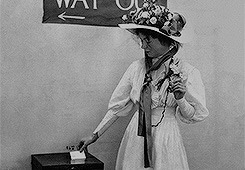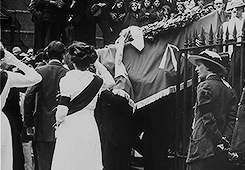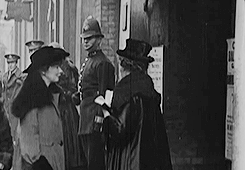margaretroses:“I know that women, once convinced that they are doing what is right, that their rebel
margaretroses:“I know that women, once convinced that they are doing what is right, that their rebellion is just, will go on, no matter what the difficulties, no matter what the dangers, so long as there is a woman alive to hold up the flag of rebellion” - Emmeline Pankhurst, 1912.6 February 1918 - the Representation of the People Act 1918 was passed by the British Parliament, reforming the electoral system in Britain and Ireland, which granted the vote to some women for the first time. The vote was extended to women over the age of 30 who met minimum property qualifications, which enfranchised 8.4 million women.Since the mid-19th century, suffragists began campaigning for female suffrage and in 1865 Barbara Bodichon formed the first Women’s Suffrage Committee, later followed by the Manchester Society for Women’s Suffrage in 1867. Suffragists like Millicent Fawcett, Lydia Becker and Elizabeth Wolstenholme believed that non-violent campaigning would lead to change, through petitions and lobbying. On the other hand, the suffragettes, famously led by the Pankhursts - Mancunian matriarch Emmeline and her daughters Sylvia and Christabel - followed a more militant approach. This method often led to imprisonment where hunger-strikes and force feeding ensued. The suffragettes adopted green, white and purple as their colours, symbolising hope, purity and dignity, and ‘Deeds, Not Words’ became the motto of the Women’s Social and Political Union, founded in 1903. The first martyr of the suffragette cause was Emily Wilding Davison who died from head injuries after being struck by King George V’s horse at the Epsom Derby in 1913. Unclear whether she intended to sacrifice her life or if it was just a tragic accident, Emily attempted to pin a ‘Votes For Women’ sash on the horse during the race, and died in hospital three days later. The streets were packed for her funeral procession and 6,000 women attended the service, wearing either white, black or purple. “The women of Britain have shown that they can share the hardships of the War … All recognise that a share in the hardship means a share in the triumph.” - David Lloyd George, PM (1916-22).After war broke out in 1914, many women of both sides channeled their energy into the war effort, hoping that they would be later be ‘rewarded’ with the vote. Without the opportunity to demonstrate their abilities during the war - holding the fort at home, running hospitals and providing essential munitions labour - the vote would likely not have been extended to women in 1918. Universal suffrage for all women over the age of 21, on equal terms with men, was not granted until 2 July 1928 - which suffragette leader Emmeline Pankhurst did not live to see, having died two weeks earlier on 14 June. -- source link
Tumblr Blog : margaretroses.tumblr.com
#suffrage movement#womens suffrage#british history







